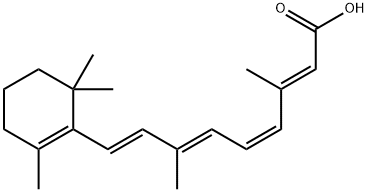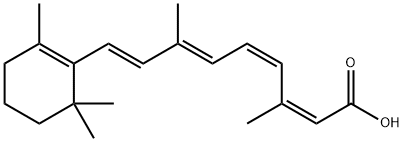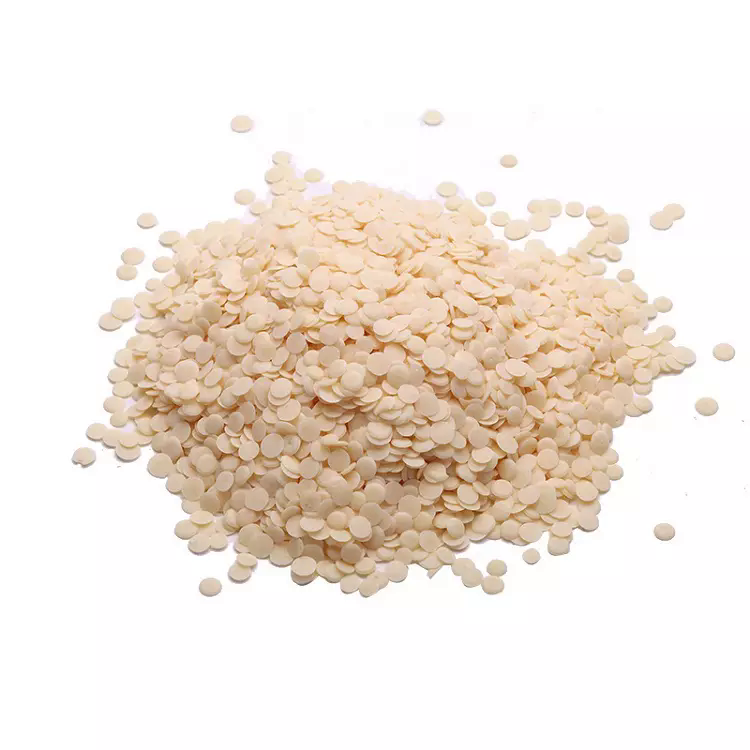9-CIS-RETINOIC ACID
Synonym(s):9-cis-Tretinoin;Alitretinoin
- CAS NO.:5300-03-8
- Empirical Formula: C20H28O2
- Molecular Weight: 300.44
- MDL number: MFCD00270072
- EINECS: 1533716-785-6
- SAFETY DATA SHEET (SDS)
- Update Date: 2024-11-19 15:53:33

What is 9-CIS-RETINOIC ACID?
Description
Alitretinoin was introduced in the US for the topical treatment of cutaneous lesions in patients with Kaposi's sarcoma (KS), the most frequent malignancy observed in AIDS patients. It is a derivative of 9-cis-retinoic acid (9- cis-RA) identified as an endogenous hormone in mammalian tissues. Alitretinoin binds to all isoforms of the intracellular retinoid X (RXR) and retinoid A (RAR) receptors thus inducing cell differentiation, increasing cell apoptosis and inhibiting cellular proliferation in experimental models of human cancer. In an international phase III trial in patients with KS, 42% of 82 patients treated with 0.1% gel formulation experienced complete or partial responses cf 7% for controls. Alitretinoin is the first topical therapy for KS and is expected to be a new option to its traditional management.
Chemical properties
Pale Yellow Solid
Originator
Ligand (US)
The Uses of 9-CIS-RETINOIC ACID
An endogenous retinoic acid isomer, which is capable of binding to both retinoic acid receptors (RAR) and retinoid X receptors (RXR). A biologically active ligand for members of the RAR and RXR subfamilies, implying that it may play a critical role in regulating retinoid-responsive pathways.
The Uses of 9-CIS-RETINOIC ACID
9-cis-Retinoic acid is a vitamin A analog that inhibits cell proliferation and induces cell differentiation. 9-cis-Retinoic acid is an inhibitor of Cox-2 and an activator of RAR α, RAR β, RAR γ and RXR.
What are the applications of Application
9-cis-Retinoic acid is a Cox-2 inhibitor that prevents cell proliferation and induces cell differentiation.
Definition
ChEBI: A retinoic acid in which the exocyclic double bonds have 7E,9Z,11E,13E geometry.
Indications
Alitretinoin (Panretin) is a naturally occurring endogenous retinoid that binds to and activates all known retinoid receptors (both RARs and RXRs). It is approved for the topical treatment of cutaneous lesions of Kaposi’s sarcoma. Most patients have local irritation while using alitretinoin gel; however, the irritation rarely necessitates discontinuation of therapy.
Background
An important regulator of gene expression during growth and development, and in neoplasms. Tretinoin, also known as retinoic acid and derived from maternal vitamin A, is essential for normal growth; and embryonic development. An excess of tretinoin can be teratogenic. It is used in the treatment of psoriasis; acne vulgaris; and several other skin diseases. It has also been approved for use in promyelocytic leukemia (leukemia, promyelocytic, acute).
Indications
For topical treatment of cutaneous lesions in patients with AIDS-related Kaposi's sarcoma.
brand name
Panretin (Ligand).
Biochem/physiol Actions
Ligand for both the retinoic acid receptor (RAR) and the retinoid X receptor (RXR) that act as transcription factors to regulate the growth and differentiation of normal and malignant cells.
Pharmacokinetics
Alitretinoin (9-cis-retinoic acid) is a naturally-occurring endogenous retinoid indicated for topical treatment of cutaneous lesions in patients with AIDS-related Kaposi's sarcoma. Alitretinoin inhibits the growth of Kaposi's sarcoma (KS) cells in vitro.
Metabolism
Not Available
Properties of 9-CIS-RETINOIC ACID
| Melting point: | 189-191°C |
| Boiling point: | 462.8±14.0 °C(Predicted) |
| Density | 1.011±0.06 g/cm3(Predicted) |
| RTECS | VH6450000 |
| storage temp. | -20°C |
| solubility | Acetonitrile (Very Slightly), Chloroform (Slightly), DMSO (Slightly), Ethanol ( |
| form | Light yellow to orange crystalline powder. |
| pka | 4.73±0.33(Predicted) |
| color | Pale Yellow to Yellow |
| Water Solubility | Soluble in chloroform (50 mg/ml), DMSO (~25 mg/ml), ethanol (25 mg/ml), and acetone (25 mg/ml). Insoluble in water. |
| Sensitive | Moisture & Light Sensitive |
| Stability: | Store Dry in Freezer at -20°C for up to 1 year; in Solution at -20°C for up to 3 Months. |
| CAS DataBase Reference | 5300-03-8(CAS DataBase Reference) |
Safety information for 9-CIS-RETINOIC ACID
| Signal word | Danger |
| Pictogram(s) |
 Exclamation Mark Irritant GHS07  Health Hazard GHS08 |
| GHS Hazard Statements |
H315:Skin corrosion/irritation H319:Serious eye damage/eye irritation H335:Specific target organ toxicity, single exposure;Respiratory tract irritation H360:Reproductive toxicity |
| Precautionary Statement Codes |
P201:Obtain special instructions before use. P302+P352:IF ON SKIN: wash with plenty of soap and water. P305+P351+P338:IF IN EYES: Rinse cautiously with water for several minutes. Remove contact lenses, if present and easy to do. Continuerinsing. P308+P313:IF exposed or concerned: Get medical advice/attention. |
Computed Descriptors for 9-CIS-RETINOIC ACID
9-CIS-RETINOIC ACID manufacturer
New Products
(S)-3-Aminobutanenitrile hydrochloride 4-Methylphenylacetic acid N-Boc-D-alaninol N-BOC-D/L-ALANINOL Tert-butyl bis(2-chloroethyl)carbamate 3-Morpholino-1-(4-nitrophenyl)-5,6-dihydropyridin- 2(1H)-one Furan-2,5-Dicarboxylic Acid Tropic acid 1-Bromo-3,5-Di-Tert-Butylbenzene S-2-CHLORO PROPIONIC ACID ETHYL ISOCYANOACETATE 2-Bromo-1,3-Bis(Dimethylamino)Trimethinium Hexafluorophosphate 4-IODO BENZOIC ACID 3-NITRO-2-METHYL ANILINE 1-(2,4-DICHLOROPHENYL) ETHANAMINE (2-Hydroxyphenyl)acetonitrile 4-Bromopyrazole 2-(Cyanocyclohexyl)acetic acid 4-methoxy-3,5-dinitropyridine 1-(4-(aminomethyl)benzyl)urea hydrochloride 2-aminopropyl benzoate hydrochloride diethyl 2-(2-((tertbutoxycarbonyl)amino) ethyl)malonate tert-butyl 4- (ureidomethyl)benzylcarbamate Ethyl-2-chloro((4-methoxyphenyl)hydrazono)acetateRelated products of tetrahydrofuran








You may like
-
 5300-03-8 Alitretinoin 98%View Details
5300-03-8 Alitretinoin 98%View Details
5300-03-8 -
 9-cis-Retinoic acid CAS 5300-03-8View Details
9-cis-Retinoic acid CAS 5300-03-8View Details
5300-03-8 -
 1975-50-4 98%View Details
1975-50-4 98%View Details
1975-50-4 -
 2-HYDROXY BENZYL ALCOHOL 98%View Details
2-HYDROXY BENZYL ALCOHOL 98%View Details
90-01-7 -
 2-Chloro-1,3-Bis(Dimethylamino)Trimethinium Hexafluorophosphate 221615-75-4 98%View Details
2-Chloro-1,3-Bis(Dimethylamino)Trimethinium Hexafluorophosphate 221615-75-4 98%View Details
221615-75-4 -
 61397-56-6 CIS BROMO BENZOATE 98%View Details
61397-56-6 CIS BROMO BENZOATE 98%View Details
61397-56-6 -
 14714-50-2 (2-Hydroxyphenyl)acetonitrile 98+View Details
14714-50-2 (2-Hydroxyphenyl)acetonitrile 98+View Details
14714-50-2 -
 118753-70-1 98+View Details
118753-70-1 98+View Details
118753-70-1